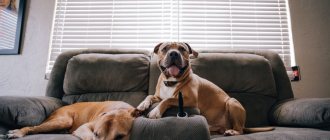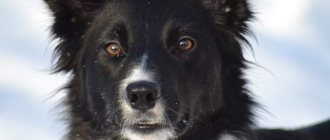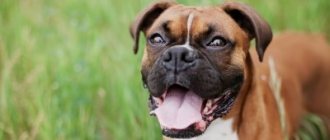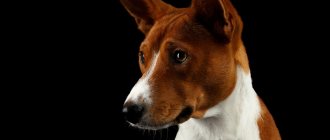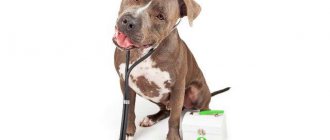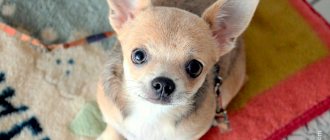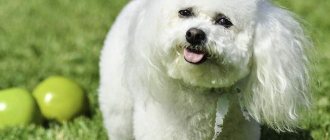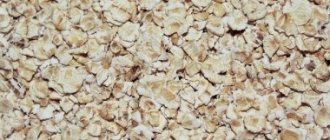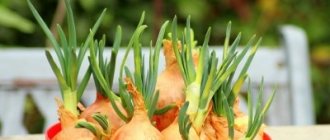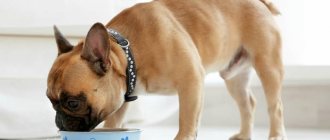/ Dogs / Dog breeds / Tamaskan dog breed
0
8933
Article rating
The Tamaskan, or Tamaskan dog, is a working dog breed native to Finland. The Tamaskan dog was bred to work in sleds, so this breed has a hardy character and resistance to frost. We obtained representatives of this species thanks to many years of crossing different breeds.
Tamaskan dog
Over time, experts improved the quality of the breed and crossed the Tamaskan with the Northern Inuit dog, Alaskan Malamute, Siberian Husky and other species. The result was a dog that looked like a wolf, with a developed body, working abilities and limitless patience.
Please note that it is recommended to have this breed at least in pairs, since this dog from birth must live in a pack, and it will be boring for it alone.
This animal is perfect for a large and friendly family, where the dog will feel like part of the pack. The Tamaskan dog is considered a rare breed, and there are only 400 registered individuals in the world, so interest in it is only growing every year.
In Russia it is quite difficult to purchase a puppy of this breed. Most often, future buyers agree in advance with the breeder and reserve the required number of puppies. When the puppies are born, the breeder informs the buyers and everyone who made a reservation comes and picks up the puppies. Basically, reservations are only possible after 100% prepayment. There is also a high probability that you will have to go to America or Europe to get the puppies.
The price of Tamaskan depends on many factors, but on average prices start at $1,200. You need to check with the breeder how much a specific puppy costs.
Before buying a pet, you definitely need the necessary information, look at Tamaskan dog photos, videos, read reviews from previous buyers, so as not to make a mistake in choosing a seller.
Content
The Tamaskan dog is an emerging modern dog bred in the UK, but with the involvement of dogs from Lapland also with some roots in Finland. It looks like a wolf, but there is no wolf in this dog, and its creators created it in order to have this noble appearance. He is intelligent and versatile, and while being an excellent companion, makes an excellent sporting dog or working dog. This dog is best suited for active and experienced owners. It is large in size and has a lifespan of 14 to 15 years.
| A Brief Overview of the Tamaskan Dog | |
| Name | Tamaskan dog |
| Other names | Formerly Utonagan |
| Nicknames | There, Tamaskan |
| Source | UK and Finland |
| The average size | Big |
| Average weight | 55 to 100 pounds |
| Average height | 24 to 28 inches |
| Lifespan | From 14 to 15 years |
| Coat type | Thick double coat, dense undercoat and coarse outer coat. |
| Hypoallergenic | No |
| Color | Gray wolf, red gray, black gray |
| Popularity | Not recognized by AKC |
| Intelligence | High |
| Heat Tolerance | Moderate - take care to care for it during the warmer months |
| Cold tolerance | From very good to excellent |
| Shedding | Average to above average and then heavier during shedding season |
| Slobber | Moderate |
| Obesity | Average – measure your food and make sure it is active daily. |
| Care/cleaning | Average to Above Average – Brush your teeth usually twice a week, but during difficult times you should brush your teeth daily |
| Barking | Random |
| Exercise needs | Tall is an active breed that needs active owners. |
| Learning ability | Quite simple with experience |
| Friendliness | Very good with socialization |
| Good first dog | Good, but easier for experienced owners |
| Good pet | Very good with socialization |
| Good with children | Very good with socialization |
| Gets along well with other dogs | Very good with socialization |
| Gets along well with other pets | Good to very good, but socialization required |
| Good with strangers | Good, but needs socialization as can be cautious |
| Good apartment dog | Low – requires space and yard |
| Copes well with loneliness | No – prone to separation anxiety because he doesn’t like to be left alone. |
| Health issues | Fairly healthy, but some problems include cryptorchidism, epilepsy, hip dysplasia and degenerative myelopathy. |
| Medical expenses | $485 per year for basic health care and dog insurance. |
| Food expenses | $260 per year for quality dry dog food and treats. |
| other expenses | $675 per year for care, miscellaneous items, toys, basic training and license |
| Average annual expenses | $1420 as starting figure |
| Purchase cost | $1,200 |
| Rescue organizations | None are breed specific, check local shelters and rescues |
| Bite statistics | No messages |
Types of sled sports
Riding sport is popular in all countries of the world. However, the climatic conditions of the regions vary, and you have to adapt to them. This was the impetus for the emergence of various disciplines. Special equipment has been created that is used in regions with warm climates. Today, sledding sports are divided into two categories:
- snowless disciplines (dryland);
- winter disciplines.
During warm and snowless periods the following tournaments are held:
- Dogtracking. Both walking and running can be used as a method of transportation.
- Canicross. A person runs a distance with a pet, which is fastened to his belt with a pull rod equipped with a shock absorber.
- Scooting. In addition to the athlete, a special scooter (scooter), as well as one or two individuals harnessed to a harness, participate in the races.
- Bikejoring. Competitions on bicycles with fastened animals. The mounting location is the steering wheel or bracket.
- Karting. From 4 to 10 individuals are harnessed to a three or four-wheeled cart.
Winter disciplines are more natural. They have developed historically. Take place during the snow season. The list of disciplines includes:
- Pulking. Competitors compete on small sleds pulled by one to four individuals.
- Skijoring. Skiers with animals tied to their belts take part.
- Sled racing. Traditional sport. For transportation, mushers use sleds or sleighs, which are connected to a team consisting of 2 to 16 individuals.
Based on the length of the route, races are divided into the following types:
- for long distances;
- for medium distances;
- sprint.
Features of feeding and diet
Many breeders prefer to feed their dogs dry food. But here you need to be careful - some cheap varieties contain dangerous allergens, to which northern Inuit dogs are especially sensitive.
Remember! When kept in an apartment, dogs are prone to obesity. It is worth remembering this and feeding them very moderately.
A more correct solution would be to feed “naturally”. The basis should be lean meat - rabbit, poultry or beef. Sometimes you can replace it with fish (sea, boiled, without large bones) or offal
It is also important to enrich the diet with vegetables (carrots, zucchini, pumpkin) and cereals (millet, oatmeal, wheat, buckwheat). It is very important to regularly provide low-fat fermented milk products - cottage cheese and kefir, as a source of calcium.
Nutrition
Very often, such dogs have stomach problems due to poor nutrition, so you need to approach feeding your pet with special care and devote the lion’s share of time to this process. You should categorically avoid fried, smoked, and especially fatty foods.
It is best to give your dog beef, and it digests it perfectly both raw and cooked. Poultry and fish can also be excellent food. High-quality dry food can be added to food to diversify it, but you shouldn’t get too carried away.
Sled dogs included in the FCI register – group 5, section 1
It is difficult for a person spoiled by the benefits of civilization to imagine in what conditions the northern peoples survived and continue to survive. Especially if you think about the times when heating could be regarded as an unprecedented technology. The daily struggle for life required backbreaking labor. People hunted, fished and reared deer. Cold, wild animals and curious strangers complicated the already difficult fate of the aboriginal tribes, and the only allies were the Northern sled dogs. The breeds recognized today are significantly different from their ancestors, as their attractive appearance attracted most northern dogs to show work. Among the diverse population of four-legged animals, the FCI recognizes only the following breeds.
Alaskan Malamute
The largest representative of sled dogs. An adult Malamute weighs 32–43 kg and grows to 64 cm at the withers. The breed is characterized by wolf coloring, furry and double-layered wool, endurance, loyalty against the backdrop of willfulness, physical strength and an excellent sense of smell. The aboriginal tribes (Malemutes) living in Alaska needed strong and versatile dogs.
The modern breed is divided into two lines:
Kotzebue is closer to its wild ancestors; it has only a wolf coloration, a tough temperament and powerful dimensions.
M'Lut are the familiar Malamutes, including show-class dogs.
In city conditions, Malamutes are even kept in apartments, although this lifestyle comes with a number of strict requirements. Representatives of the breed need daily exercise, long walks and intellectual development. Tailed animals do not tolerate loneliness well, since they are more accustomed to living in a large flock. The dog quickly becomes attached to the owner, respects and loves all family members. Malamute is tolerant towards children, but it is not worth having him as a nanny.
Greenland sled dog
The rarest breed of the group. Adult dogs grow up to 64 cm at the withers and 32 kg. Representatives of the breed obey only the owner, and only if the commands do not contradict the pet’s mood. “Greenlanders” are prone to making independent decisions and running away, protecting the territory that they consider theirs.
The breed is not recommended for novice owners; it is also not worth getting a Greenland sled dog for apartment living. Tailed animals need exercise, and games and runs are not enough for them. The ideal activity for the breed is towing a skier, cyclist or load.
Siberian Husky
The most famous representative of the group is the blue-eyed Siberian Husky. Initially, the breed was “canned” and was used in the everyday life of the northern peoples. After gold was discovered in Alaska and the Gold Rush began, the value of sled dogs increased. Travelers and hunters for profit brought their dogs to the north, and took home not only gold, but also the indigenous four-legged inhabitants.
The sled dog's career was interrupted by the breakthrough and breeding of the first Husky with blue eyes and a black shirt. Photos of incredibly beautiful dogs spread around the world at an enviable speed, and the demand for puppies grew at a similar pace. People cared little that the purpose of dogs could not be realized in the world of asphalt and concrete. Breeders, adapting to demand, instilled “urban traits” in dogs. The repurposing happened so quickly that real Huskies became rare. Today the breed is divided into:
Alaskan Huskies are native dogs.
Siberian Huskies are companions, show dogs that have not lost (partially) their working skills.
Samoyed (Samoyed Husky)
The most attractive and charming representative of sled dogs. The friendly four-legged dog with the eternal "Eskimo smile" is increasingly seen as a family dog. The strange name - Samoyed, was assigned to the dog after the “name of the first owners,” the Samoyed tribes. By the way, the theory that Samoyeds were intensively used as sled dogs has been doubted more than once. The tribes in which the dogs lived led a nomadic lifestyle and the four-legged dogs had to carry sleighs, but their main job was protection and hunting.
Samoyeds are considered medium-sized dogs (up to 60 cm), but due to their fluffy coat they appear large. Centuries-old cooperation with people has instilled in the representatives of the breed loyalty and the ability to understand the owner at a glance. At the same time, severe hardening instilled in Samoyeds good health and endurance. Laikas are prone to workaholism and this should be taken into account when getting a dog in an apartment. As an alternative to work, four-legged dogs are trained in dog sports, mainly bike and skijoring.
Unrecognized
Breeds not recognized by the FCI include:
- Norwegian sports mestizos;
- Eskimo husky;
- wolf-dog;
- Sakhalin Husky;
- Chinook.
Norwegian sporting crossbreeds
Norwegian mixed breed Norwegian mixed breeds are the fruit of the painstaking work of the hands of breeders who carried out matings between:
- greyhounds;
- kurtshaars;
- pointers.
The dog was created specifically to participate in sports competitions and has good physical characteristics combined with a gentle disposition.
Buying such a puppy is not easy. Due to the lack of official confirmation, it is difficult to confirm the quality of the animal being purchased.
Eskimo Husky
The Eskimo Husky is a medium-sized North American native dog. The animal is not suitable for families with small children and needs access to constant work.
The Laika is quiet, friendly, hardworking and has hunting skills. The fearless animal was used to hunt polar bears.
The pet is not suitable for keeping in warm climates and is susceptible to sunstroke.
Due to their rarity (there are no more than 5 hundred officially registered animals), the cost of puppies reaches 420 thousand rubles.
Wolfdog
Wolfdog Wolfdog are unique hybrids obtained by crossing wild wolves and German shepherds. The attractive appearance inherited from the wolf and the character inherited from the shepherd allowed the animal to be used in dog sledding and service work.
It will not be possible to purchase such a pet, since sales are prohibited. The breeding project and the results obtained belong to Russian scientists.
Sakhalin Husky
Sakhalin Husky The result of crossing Akita Inu and Spitz from Japan. Animals are fearless, prone to dominance and strongly attached to their owners.
With prolonged loneliness, Sakhalin residents develop severe psychological problems leading to physical illnesses.
Prices for puppies start from 20 thousand and reach 50 thousand rubles.
Sakhalin Huskies are not suitable for apartment living and will throw a real concert after the owner leaves for work. At the same time, they perceive the harsh conditions of the Far North with ease, enjoying participation in human expeditions.
Appearance of the Tamaskan dog
The Tamaskan dog is quite large, slender and strong. Outwardly, she is very much like a wolf, only her eyes, which show interest and curiosity, betray her devoted and responsive canine nature. Movements are fast and easy. Sexual dimorphism is pronounced.
- The height at the withers is 63-71 cm.
- Weight about 30 kg.
The head is proportional to the body. The eyes are almond-shaped, medium in size, with an attentive and intelligent expression. The muzzle tapers slightly, forming a blunt wedge. The nose is large and black; in winter a “snow nose” is allowed. The bite is correct, scissor-shaped, the teeth are large and complete. The neck is strong and quite long.
The Tamaskan dog stands firmly on its feet, giving the impression that it is always ready for action. Graceful, free with a proud posture and raised head. The back is straight and level. The croup is slightly sloping. The chest is deep and wide, reaching to the elbows. The tail is set low, long and straight. The limbs are of medium length, strong with developed muscles and strong bones.
The coat is thick, straight, and of medium length. The undercoat is soft, its amount depends on the climate and time of year. Colors:
- Red-gray;
- Wolf grey;
- Black and gray agouti.
Where and how to buy a Northern Inuit dog puppy
This breed is not common in the Russian Federation, so purchasing a puppy will be quite problematic. Today there is not a single domestic nursery for breeding the Northern Inuit dog. Thus, if you want to acquire an exotic, you will have to order it directly from UK nurseries. There is a queue for puppies even before they are born, which also affects the cost. The price for a dog varies from 20,000 to 30,000 Russian rubles, plus you will have to pay transportation costs.
Sometimes on Internet sites like Avito you can find an advertisement for the sale of purebred Northern Inuit dog puppies. But there is a high probability of stumbling upon an unscrupulous seller who sells a cross between huskies and other breeds. To avoid becoming a victim of deception, you should consult a dog trainer before purchasing a pet.
Today, the cost of one Inuit dog puppy varies between 20,000–30,000 Russian rubles
Literature
- Escimo Dog of the Canadian Arctic // Canadian Geographical Journal. - 1940. - No. 2. - P. 97-108.
- Geneviève Montcombroux.
The Inuit Dog of the Polar North: Revised and expanded third edition of The Canadian Inuit Dog: Canada's Heritage. 3rd Edition. — CreateSpace Independent Publishing Platform, 2022. — 220 p. — ISBN 978-1517610579. - Max Murray.
Canadian Eskimo Dog Training Guide. — CreateSpace Independent Publishing Platform, 2022. — 112 p. — ISBN 9781534978775. - Tammy Gagne.
Huskies, Mastiffs and Other Working Dogs / Capstone Global Library Limited. - London: Raintree. — ISBN 9781474720861.
Photos and videos
The gallery contains more photos of dogs of the Canadian Eskimo Laika (Inuit dog) breed.
Canadian Eskimo dog
Despite the fact that the breed is one of the most ancient - according to some sources, it is more than a thousand years old! – at the moment there are very few purebred representatives left, so it is not surprising that the price for a puppy can be tens of thousands of dollars.
This breed appeared in Siberia, from where its representatives were exported to Alaska, Canada and Greenland, so calling this dog Canadian is not entirely correct. It would be more correct to use the Eskimo name “kingmik” to designate the breed, but due to the not very convenient pronunciation, it is currently used only by the Eskimos themselves. Sometimes they talk about her as a husky.
The Canadian Eskimo dog is conventionally classified as a sled breed. Its closest relatives are the Greenland dog and the Alaskan malamute. Like representatives of these breeds, the Canadian dog is perfectly adapted to survive in the harsh conditions of the Far North. For example, these animals can sleep in the snow without the threat of hypothermia and work in severe frosts down to -50°C. And all thanks to their amazing incredibly thick fur, which has a fatty lubricant: it not only protects from the cold, but also repels water.
Externally, the Canadian Eskimo dog is very similar to the Malamute, although it is more “compact” and has a lighter frame, which does not in the least prevent it from transporting heavy loads over long distances. By the way, this breed can also compete with the Malamute in endurance. The coat color of an Eskimo dog can be absolutely any color, but the eye color is always brown.
They also have one more common feature with Malamutes: neither one nor the other bark, but rather howl like wolves, in different ways.
The main difference is that Canadian dogs are excellent hunters, in which Malamutes are still inferior to them. Representatives of the breed are able to cope with seals and even polar bears.
Like most native breeds, the Canadian Husky enjoys excellent health. Thanks to this, some representatives of the breed become real long-livers. There are cases where these dogs lived for more than 20 years!
True, immunity, alas, does not save from other problems inherent to the breed. Like other northern sled dogs, Canadians are susceptible to joint dysplasia. Although most often this disease occurs in those animals whose weight is more than normal. They also have eye diseases, epilepsy, and various allergic reactions. But, fortunately, all this is quite rare.
At first glance, it may seem that the Canadian Eskimo dog is great for inexperienced owners and is generally an easy pet to keep. But that's not true. This is all due to the difficult nature of these animals. They are stubborn, assertive, dominant, always on their own and are able to make their own multi-stage decisions, which they do with enviable consistency. Therefore, only a very patient, friendly and self-confident person can properly raise such an animal. However, with proper upbringing, Canadians grow up to be surprisingly devoted and faithful. True, these dogs tend to choose only one person whom they will obey and respect, and simply tolerate everyone else (if they grow up in a large family).
Despite the fact that it is possible to find advertisements for the sale of puppies of this breed on the Internet, the likelihood that these will turn out to be purebred Canadian Eskimo Husky puppies is, alas, almost zero. The fact is that there are practically none left. It’s good if there are at least a dozen purebred individuals. In addition, they are under strict control. And the puppies that are born cost truly fabulous money.
Intelligence:
Aggressiveness:
For security:
For children:
Training:
Difficulty in care:
The breed was formed in very harsh and difficult climatic conditions for life in Eastern Siberia. The dogs had to do the hard work of dragging loads, and the breed was created for these purposes. In the 20th century, the Eskimo Laika breed became widespread in Alaska and Greenland. These dogs are very hardy, are not afraid of strong snowdrifts, frosts, and have a strong-willed character. Good guards and hunters, they were often used to catch polar bears.
This variety of huskies is quite closely related to the following breeds:
- Siberian Husky.
- Malamute.
- Laika Samoyed.
Notes
- Top Dogs Retrieved December 23, 2012
- Jo Kelly.
The Canadian Eskimo dog // Sled dog central. — Date of access: 01/26/2018. - qimmiq at the Inuktitut Living Dictionary Retrieved December 23, 2012.
- Wilfred T. Grenfell.
“The Dogs” (English) //
Wilfred T. Grenfell, CMG, MRCS, MD (Oxon.) and Others
Labrador: The Country and the People: book. - New York: The Macmillan Company, 1909. - Iss. X. - Archived copy. Retrieved May 5, 2014. Archived February 3, 2014.
- Inuit Sled Dogs in the Baffin Region, 1950 to 1975 Archived July 15, 2011. Qikiqtani Truth Commission
- Population Genetic Analyzes of the Greenland dog and Canadian Inuit dog
by Hanne Friis Andersen, page 39. See also Greenland Dog / Inuit Dog….
it makes no difference in The Fan Hitch
Volume 7, Number 4, September 2005
Journal of the Inuit Sled Dog International
. Retrieved December 23, 2012 - Canadian Ian Kenneth MacRury.
The Inuit Dog: Its Provenance, Environment and History (English) // The Fan Hitch: Journal of the Inuit Sled Dog. — 1991. - Canadian Eskimo Dog Foundation - About Archived February 1, 2014.
- Legislative assembly of Nunavut: The Canadian Inuit Dog (CANIS FAMILIARIS BOREALIS) – Official Animal of Nunavut
- Motion 25 - 1(3): Official Emblems, Monday May 1, 2000, Nunavut Hansard, Page 2049
- Ole Gjerstad
Qimmit: A Clash of Two Truths.
Documentary film
. National Film Board of Canada. Retrieved November 2, 2011. - Bell, Jim
.
RCMP: Dogs killed for health and safety, Nunatsiaq News
(December 8, 2006). Archived March 6, 2012. Retrieved December 23, 2012. - Final Report: RCMP Review of Allegations Concerning Inuit Sled Dogs Archived April 16, 2014.
- Canadian Kennel Club: Canadian Eskimo Dog breed standard. Retrieved April 28, 2007
- The Kennel club UK // https://www.thekennelclub.org.uk. — Date of access: 01/26/2018.
- Fauna Boreali-americana, Or, The Zoology of the Northern Parts of British America: Containing Descriptions of the Objects of Natural History Collected on the Late Northern Land Expeditions, Under Command of Captain Sir John Franklin, RN by John
Richardson, William Swainson, William Kirby, published by J. Murray, 1829 - New Zealand Kennel Club: Canadian Eskimo Dog breed standard. Retrieved December 23, 2012
- Polar Controversy Archived May 30, 2008. Retrieved December 23, 2012
- Eskimo dog (Russian) // Soviet Arctic: Political and economic journal of the State Administration of the Northern Sea Route. - 1940. - September (No. 9). — P. 62-63.
- Australian National Kennel Council LTD : archive of breed standard. — Date of access: 01/26/2018.
- Raising and maintaining a Canadian Eskimo dog // https://tutknow.ru: educational online magazine. — Date of access: 01/26/2018.
- Qimmiq — Dogs Retrieved December 23, 2012
- nanuq (inaccessible link) at the Inuktitut Living Dictionary Retrieved December 23, 2012.
- The Menageries: Quadrupeds, Described and Drawn from Living Subjects
by James Rennie, Society for the Diffusion of Useful Knowledge (Great Britain). Contributor Charles Knight, William Clowes, Longman, Rees, Orme, Brown, and Green, Oliver & Boyd, published by Charles Knight, 1829 - Coppinger, Ray.
Dogs: a Startling New Understanding of Canine Origin, Behavior and Evolution. - 2001. - P. 352. - ISBN 0-684-85530-5. - The Variation of Animals and Plants Under Domestication Part One
by Charles Darwin, 1885 - Inuit Sled Dog International Retrieved December 23, 2012
- Summary of Hunting Regulations 2010/2011 Archived May 20, 2013. page 7
- 2012-2013 Summary of Hunting Regulations Archived September 4, 2012. page 20
- The Seven Wonders - Animals Retrieved December 23, 2012
- Polar Bear World Archived October 16, 2007. Retrieved January 17, 2007
- Laura Pitblado.
LARQUOIA KENNELS. Home of the Indigenous and Majestic Canadian Eskimo Dog // https://www.canadianeskimodog.com. — Date of access: 01/26/2018.
Character and behavior
The Greek Shepherd is independent, brave, determined, and loyal. A tireless worker with a strong sense of duty and protective instinct.
The main function of Greek Shepherds is to accompany and guard livestock. Character and behavior correspond to purpose. These dogs are very vigilant and brave, they watch every charge and relentlessly follow the herd. They are quite independent in behavior, have pronounced aggressiveness towards wild animals and enough courage to, if necessary, engage in a fight with a wolf or even a bear. They are very loyal and work well in a team, both with humans and other dogs. Mentally and physically develops late.
Greek Shepherds have a well-developed sense of smell, vision and hearing, which, combined with a powerful physique and balanced character, makes them ideal guard dogs.
Working Greek dogs that go to the mountains with a cat must be constantly on alert, because wolves, although few in number, exist. This made it possible to preserve the skills of the wolfhounds
When accompanying the herd, they move carefully and do not disturb the other animals. The Greek Shepherd becomes attached to one owner, whom he recognizes as the leader and obeys. The rest are perceived as wards and do not allow themselves to be controlled
Wary with strangers, not prone to causeless aggression
The rest are perceived as wards and do not allow themselves to be controlled. She is wary of strangers and is not prone to causeless aggression.
Of course, not all Greek Shepherds have the necessary qualities to climb mountains with livestock and fight wild animals, but they are all wonderful companions that easily adapt to human requirements. They may just be pets, but they do not forget about their guard duties.
Character
The Azawakh is a very intelligent breed, as well as strong, loyal and therefore requires respectful treatment. She has a noble appearance and a balanced psyche.
The behavior of a breed is directly related to its purpose. She was created for hunting, and therefore knows how and will protect herself and her owner in any situation. The Azawakh does not attack just like that, it needs a reason - aggression. But if a stranger or another animal gives a hint of aggressive actions, she will not wait for the owner’s command and will rush into battle.
It is for this reason that it is not recommended for families with children. Her behavior is somewhat unpredictable. But while adults understand what to watch out for and how to behave with a dog, children do not. A loud cry or fast movement can provoke a dog to respond. Moreover, if a child and a dog grow up together, a very strong friendship will be established between them.
She shouldn’t live in a house with other animals either, at least if the second pet shows signs of leadership. The Azawakh is used to being dominant; he will not tolerate a competitor on his territory.
Otherwise, the pet is obedient, flexible, loves its family, but will only allow itself to be stroked by a select few, those it trusts and respects, usually only its owner.
Owner reviews
Yuri : “At work, such a little animal lived with us. I went to the border at the age of 18, and left at 32. So we were together all the time, we got along very well. Of course, you can't relax. But he became attached to the dog. There’s nothing scary with her.”
Valentina : “One day I was walking with my husband and daughter and wandered into a bird market. There, one girl was offering some very cute puppies. We took a closer look, but we didn’t like the mouth: the fangs were too terrifying. And then she told us that this breed, it turns out, was a mixture of a wolf and a dog. This has become truly scary! Moreover, they sell them without documents or any certificates, so they fled from there without looking back.”
Vladislav : “We live in a private house outside the city, there are no other houses nearby - just taiga. A colleague sent me a photo with a huge dog, I couldn’t stop looking at it. Then he said that it was a cross between a wolf and a dog and offered to buy a puppy. The price, of course, is astronomical. It was both scary and interesting. In general, we agreed that I was taking the puppy, but if something went wrong, I could return it. As a result, the dog grew up and was affectionate with us, but if one of the dogs wanders into the yard, it’s a disaster! All the dogs in the area were torn to pieces. I had to refuse. Pathetic
Education and training
Japanese breeders prefer not to talk about the secrets of training and preparation for dog fighting, so in raising an animal they will have to rely on domestic basic OKD and ZKS programs. But first, of course, socialization. Walk the puppy outside so that he gets used to the noise and presence of other people, introduce him to your pets and allow him to participate in your parties with friends - the dog should know by sight everyone who enters the owner’s house.
It’s better not to forget about your own authority either. Always go out the door and eat dinner first, leaving the puppy to be content with a supporting role, do not let the young Toshi lie on your bed and squeeze your baby less in your arms. A dog should see a person as a strong, fair owner, and not as a playmate or, worse, a foster parent blinded by love. In general, raising a Tosa Token should be done, if not by a specialist, then by an experienced owner. Moreover, this should be one person, and not all household members who have a free minute.
Training Japanese Mastiffs is a long and energy-consuming process. This is a completely special breed, not without a bit of stubbornness, which is in no hurry to carry out commands and categorically does not accept raised tones. For this reason, Western dog trainers prefer to use the method of positive reinforcement in training - Tosa Inu respond more readily to treats and affection than to severe reprimands. A clicker used in combination with a treat can be a good help in creating positive motivation.
In addition to commands, Tokyo fighting dogs are able to understand sign language and noise effects. Pointing to an object/subject, clapping your hands, waving your hand, snapping your fingers - if you are not too lazy to give a specific meaning to each of the listed combinations, the Tosa Inu will easily remember them and react instantly. As for the bad habits that sumo dogs will have to be weaned from, the most common among them is the desire to chew on anything and everything. Usually all puppies are guilty of such pranks, but Tosa Inu has a special scope in such matters.
Making a puppy forget about his “biting” addiction to furniture and human hands is not easy, but it is possible. For example, buy new, interesting toys and hide the old ones. At first, an enthusiastic animal will chew balls and rubber squeakers brought from the store, and then, when he gets tired, you can return the old toy supplies. Sometimes the Tosa Inu bites and gnaws from idleness, so the more often the pet walks and exercises, the less energy and time it has for destructive hobbies.
Tamaskan dog brief description
The Tamaskan dog is a very good sled dog that was bred in Finland, but despite all its positive qualities, it has not yet been recognized by any canine organization. If you decide to buy a Tamaskan dog puppy, then be sure that you will get an excellent friend, a loyal comrade and a worker who is very easy to raise. Thanks to its ancestors, this breed of dog has a fairly good performance in harness. There are only 400 adult individuals of this dog in the world, which is why it is considered very rare. The dog has a rather large build; it is slightly taller than its relative, the German Shepherd. Very similar to gray wolves.
Standard
The Tamaskan dog is a sled breed, which is characterized by a rather large and strong body covered with thick hair, most often gray in color, less often red-gray or black-gray, as well as rectangular ears of medium size. Such dogs live about 15 years, depending on the conditions of their keeping.
High intelligence, devotion to their owner and obedience - these are the qualities that best describe such dogs. This dog will become an indispensable friend for your child, and it has no problems with other dog breeds; they get along well even with the smallest dogs. You can buy a Tamaskan dog only in kennels in Finland. The price for it is not announced and it is impossible to say for sure.
general characteristics
Incredibly fast Azawakhs can easily catch a hare and even a gazelle, which is why they are most often bred and trained for hunting. It is believed that this dog is sometimes capable of reaching speeds of 65 km/h, and can chase prey for as long as 5 hours without getting tired! After the victim is caught, the Azawakh usually does not kill it, but only damages the tendons so that it does not escape and falls into the hands of the owner while still alive.
Previously, as soon as the breed appeared, it was also bred for the purpose of protection. These are loyal dogs, so if desired, if the owner teaches the animal the necessary commands, the pet will easily guard an apartment or even a house. In addition, due to its exceptional appearance and docile nature, the Azawakh is popular as a pet and as a show and competition pet.
According to the standard, the height at the withers is from 58 to 74 cm, the weight ranges from 17 to 25 kg.
Character
The Azawakh is a very intelligent breed, as well as strong, loyal and therefore requires respectful treatment. She has a noble appearance and a balanced psyche.
The behavior of a breed is directly related to its purpose. She was created for hunting, and therefore knows how and will protect herself and her owner in any situation. The Azawakh does not attack just like that, it needs a reason - aggression. But if a stranger or another animal gives a hint of aggressive actions, she will not wait for the owner’s command and will rush into battle.
It is for this reason that it is not recommended for families with children. Her behavior is somewhat unpredictable. But while adults understand what to watch out for and how to behave with a dog, children do not. A loud cry or fast movement can provoke a dog to respond. Moreover, if a child and a dog grow up together, a very strong friendship will be established between them.
She shouldn’t live in a house with other animals either, at least if the second pet shows signs of leadership. The Azawakh is used to being dominant; he will not tolerate a competitor on his territory.
Otherwise, the pet is obedient, flexible, loves its family, but will only allow itself to be stroked by a select few, those it trusts and respects, usually only its owner.
Character and features
Representatives of the breed have a warlike character. Brave and courageous Afghan Shepherds cannot tolerate strangers. The Kuti (Persian name for the breed) was bred to guard nomads. Later, their duties included guarding livestock.
“Afghans” differ from the same Alabais (Central Asian Shepherd Dogs) in that they are absolutely not suitable for keeping in an apartment. The characteristics of the breed imply the presence of aggression developed over centuries. This attitude towards strangers and animals will not bring anything good if the animal lives in the city. There will be problems with walking your pet. No one will enter the owner’s house; the kuti will protest strongly. And one menacing bark may not be enough here.
The dog guards its territory very jealously. It often extends much further than beyond the boundaries of the site and the house. A huge dog is lying near the house. To someone who has not had experience with an Afghan Shepherd, the dog will seem completely relaxed. She looks detached and sleepy. The four-legged guard decided that this was an enemy. With amazing speed he attacks, forgetting about his own relaxation. Representatives of the breed know how to accumulate energy in order to act quickly and decisively at the right moment.
The Afghan Shepherd is absolutely not suitable for keeping in the house.
The male is larger than the female. But he is calmer. Bitches are aggressive and cocky, despite their small size compared to males.
It is quite difficult to determine the breed and find out whether a person is an Afghan Shepherd or a Central Asian. Only a professional can handle this matter. Dogs have different faces and heads. The scarlet has a more rounded head, and the muzzle does not narrow and does not widen towards the bottom
This knowledge will help a person behave more carefully before sage koche. It is dangerous to provoke representatives of the breed into aggression.
Attitude towards people, children and pets
Kuti was bred as a guard dog. The breed is loyal to children, even gentle towards them. But she will not become a nanny for kids. Too serious animal.
The shepherd role was imposed on the representatives of the breed a little later, when other representatives of nomadic tribes settled in the north of Afghanistan. They needed to live somehow. And sheep breeding began. Herbivores wanted to eat, they had to be protected. There were few hunters of other people's property back then. But the predators did not hesitate to steal one or two sheep. Dogs protected flocks from animal attacks. A little later, unscrupulous people were added to them. The breed has a sharply negative attitude towards strangers.
Sage koche reacts aggressively to a stranger
Afghan Shepherds are not very fond of pets. Representatives of their breed are treated tolerantly in their homeland. They were bred to work together, and from childhood the puppies are taught to live in a pack. Cats are not very popular, and neither are wolf-like dogs. They don’t take flocks and livestock into account; they know that they must be protected.
Security qualities
Sage koche is able to distinguish only family members from strangers. If the stranger turns out to be a relative or friend of the family, that’s his problem. Is the Afghan Shepherd a stranger in the territory? He will be immediately attacked, the dog will not figure out whether the person came with good intentions or bad ones. Kuti does his job quickly and accurately.
History of the Spanish Mastiff breed
The past of the Spanish Molossians is rooted in transcendental antiquity. The first literary mention of the breed dates back to the second half of the 4th century BC. It was Virgil’s didactic poem “Georgica” - a colorful story about cattle breeding, agriculture and viticulture of that time.
There are versions that mastiffs appeared much earlier: long before the Roman invasion of the Iberian Peninsula. One theory connects dogs with Phoenician merchants, the second - with nomads from Asia. “Spaniards” have an external resemblance to Tibetan mastiffs, Caucasian and Sharplanin shepherd dogs, which suggests that these breeds have a common ancestor.
The first Spanish mastiffs were more modest in size, but they were enough to protect livestock during drives. So representatives of the breed became hardworking shepherds. They were valued for their professional qualities - poise, courage and independence. The latter was extremely important, since at night the dogs were left without their master’s accompaniment and solely played the role of guard.
If necessary, the “Spaniards” could protect livestock from attacks by wild animals: wild boars, wolves and even bears. During the migration, the mastiffs led the herd for several days, doing well without food and not allowing themselves to attack their “wards”.
Basically, the Spanish breed was used for herding sheep. The dog was assigned to a flock of one thousand heads. Mastiffs were subjected to strict selection, assessing not only working qualities, but also external characteristics
First of all, cattle breeders paid attention to the size of the head and the depth of the animal’s body.
For a long time, the “Spaniards” played the role of purely working dogs and did not attract the attention of cynological organizations. The first registration of representatives of the breed took place at the beginning of the 20th century. The lucky winner was a piebald male named Machaco, who took part in the international dog show in Madrid.
At the same time, active urbanization has caused a reduction in pastoralists and, as a consequence, in the number of mastiffs. The existence of the breed was negatively affected by the Spanish Civil War and the subsequent crisis.
The lucky winner was a piebald male named Machaco, who took part in the international dog show in Madrid. At the same time, active urbanization has caused a reduction in pastoralists and, as a consequence, in the number of mastiffs. The existence of the breed was negatively affected by the Spanish Civil War and the subsequent crisis.
The breed was preserved thanks to shepherds who continued to keep sheep. It was they who provided the dogs for further selection. The first standard appeared in 1946 through the efforts of breeder Luis del Portillo. He traveled extensively throughout the province of Leon in search of the largest specimens for breeding. 20 years later, another breeder, Amodel Alejandro, began working on the development of the breed. His pets became the progenitors of the modern lines of “Spaniards”: El Pinotara, Sacaries Pieto, Hermiño Tascon and Manalo Martineda.
The final breed standard appeared in the 1970s, but mastiffs were not officially recognized until 1982. At the same time, breeder Carlos Solas developed a new dog breeding program. Today there are about 10 official kennels where you can get a faithful friend of the Spanish Mastiff breed.
Appearance
Rafeiro do Alentejo is a large, powerful dog with a moderately elongated body and a massive head. Outwardly somewhat rustic. Sexual dimorphism is well expressed.
- Height of males - 66-74 cm; weight - 45-60 kg;
- Bough height - 64-70 cm; weight - 35-50 kg.
The head is massive, proportional to the body, voluminous. The muzzle is straight, wide and deep, gradually tapering towards the nose. The lobe itself is slightly tilted back, black in color. Lips of medium thickness, clearly defined. The jaws are strong, the bite is scissor, let's say straight. The eyes are small, oval, set horizontally. The ears are triangular in shape, small, with rounded tips, narrow at the base, set at medium height, hanging down to the sides of the head. The neck is short with a single longitudinal dewlap.
The body is muscular, long, voluminous, very strong. The back is almost horizontal, long. The loin is wide, slightly convex. The croup is slightly sloping. The chest falls to the elbows or slightly lower, is wide, and does not protrude forward. The abdomen is weakly tucked. The tail is thick at the base, long, slightly curved at the tip. Limbs with strong bones and developed muscles, widely set, vertical. The movements are heavy and slow.
The coat is of medium length, straight, dense, thick to the touch, and evenly covers the body. There are also dogs with short hair. Colors: wolf, black, yellow or fawn with white markings, with or without brindle. And also white with markings of the indicated colors.
Your puppy's price tag
The Tamaskan dog is not common and therefore there are fewer breeders than reputable ones. This may mean that finding one you're comfortable with and can trust will take a little more work, but it's not something you should rush through
It is important to avoid puppy mills, backyard breeders, and even pet stores. Tam's puppy price now is probably around $1,200
Adoption is less expensive, you can adopt a rescue or shelter dog for $50-$400, but the dog is more likely to be a random mix and more adults need a new home and owner than a puppy.
Once you've found a dog or puppy you want to take home, there are some things you can buy for them once they're home. A crate, bowls, carrier, bedding, leash and collar cost about $200. When he is with you, he needs to go to the vet. He needs a physical exam, blood tests, deworming, vaccinations, microchip, spay or neuter and the like for another $190.
Additionally, there are ongoing costs of owning a pet. When you combine this into annual costs, there are three main areas: medical needs, food, and others. Tam's quality dry dog food and dog treats will start at $260 per year. Basic health and medical needs such as vaccinations, tick and flea prevention, pet insurance and wellness exams cost about $485 per year. Other miscellaneous expenses such as grooming, license, basic training, toys and other items total around $675 per year. This is a total estimated cost of $1,420 per year.
